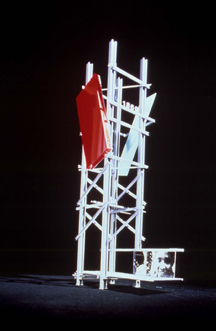ABOVE: A Bernie Miller/Alan Tregebov "cancellation mark."
Exhibition: 8 September to 17 October 2003
8 PM - Tuesday 16 September Alan Tregebov/Bernie Miller Lecture, Centre Space, Faculty of Architecture, University of Manitoba.
NOON - Wednesday 17 September: Public Art Forum at Centre Space, Faculty of Architecture held in co-operation with the University of Manitoba Faculty of Architecture and the Winnipeg Arts Council.
3 PM - Wednesday 17 September Gallery One One One reception with the artists present.
Terminations of View: A Series of Proposals
by Bernie Miller and Alan Tregebov
Essay by Cliff Eyland.
Bernie Miller and Alan Tregebov are iconoclasts who would rather block images from view than break them. Like the culture jammers at Vancouver's AdBusters magazine who want us to turn off our television sets, or punk bands -- for example New York's Le Tigre -- who urge us to turn off the Internet, Miller and Tregebov would save our gaze from the ubiquitous outdoor advertisement.
Perhaps "distract" our gaze might be a better word, because blocking signage with other signage obscures offending ads only from certain angles. Tregebov and Miller's urban activism is demure, as it would merely shield the eyes from the offensive thing. Unlike the more violent adbusters, Miller and Tregebov do not do billboard "skulling," nor do they spray graffiti in public places. They are not vandals. They admire the non-violent tactics of activists like Martin Luther King, Jr. enough to have entered and made it to the final stages of an international competition for a King monument for Washington. 1
Miller and Tregebov remind me of Diogenes the Cynic who, when asked by Alexander the Great what favour the conqueror might bestow upon him urged the king to get out of his sunlight. Imagine Diogenes casting a shadow over Alexander!
The proposal-as-art is not quite the same thing as the architectural fantasy or the unbuilt building, because from the beginning the proposal-as-art is imagined as a complete work. Tregebov the working architect could easily see to the actual construction of the proposals shown in this exhibition, but like the pioneer conceptual artist Lawrence Weiner who since the late 1960s has made verbal proposals that needn't be built, Miller and Tregebov hold that the actual construction of a piece is unnecessary or unworthy of pursuit. Part of the appeal of the Miller/Tregebov proposal -- as opposed to say the preliminary drawing for some structure that we know will be built -- is the opportunity for play opened up to viewers.
Take, for example, their homage to the anarchist called Veer, monument to Emma Goldman. Veer... is a 1:15 scale model made of plastic, glass, and film that measures 20 x 40 x 65 cm. It was made in 1997 and is the central work of this exhibition.

ABOVE: Veer, monument to Emma Goldman
plastic, glass, film, 20 x 40 x 65 cm, 1:15 scale model, 1997.
The artists submitted Veer's model and drawings as a proposal for a Toronto public art competition. Like their other proposals at Gallery One One One, Veer... is a "...tower that supports signs of erasure that will visually block or interfere with the sight lines to the commercial structures and images." (ibid.) If built Veer... would take the form of a huge structure with a large red rectangle askew its top that would obscure the ads at one of Toronto's "terminations of view." As Bernie Miller explains in a recent artist's statement:
In urban design 'terminations of view' are very important locations at which
ideally would be located major symbolically meaningful buildings or
structures. Churches are often located on such sites as are city halls and
monuments. We think that it is symbolic that these sites are predominately
seized upon by advertisers and commercial interests.
Miller and Tregebov attempt the impossible: their public monument incorporates a "negative hermeneutic" in the creation of an anti-monument that is meant to take up space in front of the ephemeral if spectacular advertisement or commercial building.
Emma Goldman is deserving of a monument, but the very destructiveness of her ideas gives pause to a civil society that must build consensus about its so-called permanent structures. One can imagine the difficulties in getting approval for such a work and how advertisers whose billboards would be blocked by this permanent piece might react to such an obstruction. 2
But why should advertising trump a monument to a great figure? After all, aren't advertisements "private" and disposable and monuments "public" and hence permanent? 3 Advertising is thought to be ephemeral and monuments are meant to last forever, but as we know, except for some politically and religiously sacred areas, very little in our cities survives the turn-over dynamic of contemporary commerce for long. Although a billboard's contents change constantly, the billboard itself can last longer than many of our public monuments and beloved buildings.
It is rare to see a logo or a commercial type form -- I think of a Coca-Cola logo in a Walker Evans photo from the 1930s -- that is used for more that a few years by a commercial company. Witness our stadia which can barely hold on to their corporate sponsor names for more than a couple of years. The recent failure in Winnipeg to preserve the historic downtown Eaton's building proves that commercial buildings, like ad campaigns, must change even as the environment of advertising in which we live becomes more permanent and pervasive than anything else in our cities.
We remember that many ancient monuments exist either because they are, like the Pyramids, too big to destroy, or, like much of Rome, because they happen to have been buried for so long. Inertia keeps yet more recent monuments standing. Because they are tucked away in unobtrusive places or because they celebrate public figures whose memory has not quite faded from public consciousness, others survive.
Could it be that the toppled monuments of post-communist Eastern Europe and the more recently felled statues of Saddam Hussein make us just that much more insecure about our own bronzes even while we allow the advertising environment to persist unchecked by public participation? The recent removal of a sculpture of Manitoba's founder Louis Riel from local government grounds should give us pause. 4 Like Emma Goldman, Riel was a complicated figure who often broke the law, and such figures resist canonization. Although we can tolerate monuments to politicians whose sins and even atrocities can be explained within the discourse of military necessity, figures like Riel and Goldman resist the platitudinous patina of the public monument.
Red Emma
The centerpiece of this exhibition is a tribute to Emma Goldman. Who was she?
Emma Goldman was the "...enemy of all government and champion of free love...," [Moritz 3] an American activist who was born in Kaunas, Lithuania on June 27, 1869 and died in exile in Toronto in May 1940 (having lived near Miller and Tregebov's Veer... site on Spadina Avenue from 1926-28) [ibid.4].
Goldman believed in equality of the sexes, birth control, worker's rights, and other ideas that are commonplace now (even if still illegal in many jurisdictions). But she was also against governments, against both capitalism and communism, and, to boot, she was no passivist, although she was against all forms of militarism.
Goldman's "Red" nickname, and hence the colour of Veer's rectangle, precedes the adoption of red as the favourite colour of the Soviet Union and other communist regimes. In fact, Goldman's first blush of red fame happened well before the Russian Revolution: in 1893 she began her radical career by holding aloft a red standard to lead a parade of female workers [Waldstreicher, 15-17] in a march up Broadway from Union Square in New York City. As a 24-year old, she was already campaigning against the working conditions of her fellow immigrants.
Goldman was a great orator and agitator, and a lover of freedom, but her attraction to political violence took years to cool off. However much it was an attention-getting device for the media campaigns that she so expertly ran in support of her causes, her attraction to violence is indefensible. When, for example, she refused to condemn anarchist murderers, including the madman assassin of the U.S. President McKinley who claimed to have been inspired by her, we detect a bait and switch tactic familiar to contemporary media manipulators as one outrageous opinion is used to get attention for a more reasonable -- if still radical -- program. But the youthful Goldman also assisted her lover Alexander Berkman in his failed attempt to kill the industrialist Henry Clay Frick, and this act went beyond an expression of sympathy for deluded anarchist killers: it was conspiracy to commit murder.
David Waldstreicher, who must want to save Goldman for the Radcliffe-style feminism of his publishers, equivocates about this famous incident: "Goldman would always hold that political assassinations were the inevitable rebellions of sensitive souls against social wrongs." [Waldstreicher, 39] This emphasis on the sensitivity of assassins is preposterous, but Waldstreicher goes further. "Goldman managed to borrow some money from her sister Helena so Berkman could purchase a pistol and a new suit." [ibid. 39] he says, admitting her part in the crime. But in the chronology at the end of his book the prevarication is transparent: "1892 Berkman attempts to assassinate industrialist Henry Clay Frick and is sentenced to 22 years in prison; Goldman is suspected of complicity." [my italics] [ibid., 107]
Capitalism would have been as affected by Frick's murder as Rembrandt's Polish Rider by the fly that I once saw crawling across his face at what is now Frick's New York Museum. Like Manitoba's Louis Riel, who also committed crimes in the name of idealism, Goldman makes civic officials hesitate when considering the bronze statue in a public place. However radical he was, a Riel statue simply must exist in the province that he founded, as it should. Goldman, however, is still too general a heroine for any particular municipality to celebrate her in bronze.
Goldman visited Winnipeg in 1927, conducting "...thirteen English meetings and five Yiddish," [Moritz, 72] (including a talk or talks at the Regent Theatre on Main and Logan, shown below in a 2003 photograph courtesy William Eakin, that I'd like to propose as an alternative site for the Goldman monument) and was roundly attacked for her opposition to the government of the Soviet Union -- an expected response given Winnipeg's post-1919 General Strike leftism and the habit then and now of falsely conflating communism and anarchism. (A Regent Theatre audience member even rudely demanded to know "How much was she being paid by capital for attacking Soviet Russia.") [Moritz, 71]

Goldman knew the Soviet Union well, having been deported from the United States to Russia in December 1919 under the provisions of the U.S. 1917/18 Espionage Act (a law that -- at least to date -- far outdoes George W. Bush's Patriot Act in its repressive punch ). This law "...establish[ed] a penalty of up to 20 years in prison for anyone who would 'utter, print, write or publish any disloyal, profane, scurrilous, or abusive language about the form of the government of the United States, or the Constitution of the United States, or the uniform of the Army and Navy of the United States.'"[Waldstreicher, 77]
Goldman was forced back to Russia, but she had high hopes -- as most everyone did -- for the possibilities of the Soviet experiment. Once ensconced, however, she was as horrified by Lenin's dictatorship as she was by America's First World War militarism.
Emma Goldman is an ideal historical figure for Miller and Tregebov to reintroduce into contemporary political debates because she was an all-round contrarian. Red Emma refused to appease her enemies or her friends for the sake of simplicity. She was always caught between ideologies and was always a political radical. Too, we need more leaders like Goldman (perhaps without the same occasional impulses to murder) who are neither pretty actresses, muscled actors, pop singers or members of royal families. This, I believe, is a hidden message of Bernie Miller and Alan Tregebov's Veer...
Deconstruction
The artistic language that Miller and Tregebov employ in their collaborations is called "Deconstructivism."
The word "Deconstruction" is most associated with the French philosopher Jacques Derrida. Artists and others have let the meaning of this word stray slightly from its philosophical sources so that it has come to refer to any critical analysis. In architecture beginning in the 1980s, the new "Deconstructivism" was associated with Derridian deconstruction and Russian Constructivist artists and architects like Goldman's contemporaries Tatlin and Rodchenko (who, when Goldman was in the Soviet Union in the 1920s, were aligning the new Cubist artistic language of Picasso and Braque with the new Bolshevist ideology). In the more recent art of deconstructivism, the cubist look, like the original constructivist art, marks Deconstructivism's territory quite distinctly from competing neo-modernist and post modernist rivals. Like Cubism, Deconstructivist architecture takes nothing for granted -- especially what is called the "program" of a building (its functions) or its visual grammar.
The skewed angles and grids of Veer... are Deconstructivist tropes, but there is more that links this exhibition with Deconstructivism, namely, its reversal of the "program" of the public monument. Instead of making something extremely visible, as we have noted, Miller and Tregebov attempt to make certain things invisible. Derrida, who has been called a radical realist by philosophers like Christopher Norris, might point out that the public monument to Riel on Winnipeg's government grounds already and inevitably deconstructs itself by, for example, reproducing a phantom presence of Riel that at the very moment of apprehension confirms that he is dead. Like the printed word that conjures the presence of say characters where none exists, the Riel sculpture tells us at once that Riel both does and does not exist.
Miller and Tregebov's reversals play with this dilemma by symbolically representing a name in a work as a "cancellation mark." They do not conjure Goldman's face but rather create a logo that literally carries on her thinking by means of its interference with the advertisements behind it.
Tregebov and Miller's deconstructivist language is not necessary to fulfill their work's function (or deliberate disfunctionality), but it does offer a kind of literary reinforcement (I do not give the word "literary" a negative connotation in my critical writing) of its negative relation to the site it hides or obscures. In exactly the same way that the original Constructivists, Dadists and Futurists announced their political radicality by using an aesthetically radical cubist form, so do Miller and Tregebov use deconstructivist form in a tribute to Emma Goldman.
Notes
1) King's theories of passive resistance derive from Gandhi and ultimately the nineteenth-century poet Shelley. (Many but not all anti-World Trade Organization protesters share these beliefs.)
2) Public monuments happen by public consensus the way war memorials do, or by coercion (I'm thinking of the dreaded Burns monuments that the Scots force on us) and so there are obvious reasons why an Emma Goldman monument may not appear in Toronto for some time. But a key point to remember is that the Emma Goldman monument could be built, that it would present an engineering firm with no problems in its realization. The impediments, to repeat, have to do with public will as regards a controversial historical figure.
3) So why block ads and commercial structures? Wasn't there a huge movement in art in the 1960s called Pop Art that embraced commercial culture? Two books, Naomi Klein's No Logo and Kalle Lasn's Culture Jam, both published at the turn of the Millennium, offer some answers in their analysis of recent activism against the rapacious conduct of multinational corporations. In both books anti-advertising -- called "culture jamming" by Lasn -- are central.
Kalle Lasn's book, as well as his Adbusters magazine, offer up techniques by which ordinary people can fight the corporate domination of their lives.
4) A fascinating discussion of the issues around the removal and replacement of the Riel statue on the Manitoba Legislature grounds happens in curator Catherine Mattes' Winnipeg Art Gallery publication Rielisms, which accompanied an exhibition.
Bibliography
Peter Brunette and David Willis ed., Deconstruction and the Visual Arts [Cambridge: Cambridge University Press, 1994]
Richard Drinnon, Rebel In Paradise a biography of Emma Goldman [Chicago: University of Chicago Press, 1961]
Naomi Klein, No Logo: Taking Aim at the Brand Bullies [Toronto: Alfred A. Knopf, 2000]
Kalle Lasn, Culture Jam: The Uncooling of America [New York: William Morrow and Company Inc., 1999]
Catherine Mattes, Rielisms [Winnipeg: The Winnipeg Art Gallery, 2001]
Theresa & Albert Moritz, The World's Most Dangerous Woman [Toronto: Subway Books, 2001]
Marian J. Morton, Emma Goldman and the American Left, Nowhere at Home [Toronto: Twayne Publishers, 1992]
David Waldstreicher, Emma Goldman Political Activist [New York: Chelsea House Publishers,1990]
The Terminations of View: A Series of Proposals by Bernie Miller and Alan Tregebov CD-ROM includes an essay and images: $20.00 plus shipping = $25.00 payable to Gallery One One One, School of Art, Main Floor, FitzGerald Building, University of Manitoba Fort Garry campus, Winnipeg, MB, CANADA R3T 2N2
TEL:204 474-9322 FAX:474-7605
For information please contact Robert Epp
eppr@ms.umanitoba.ca



